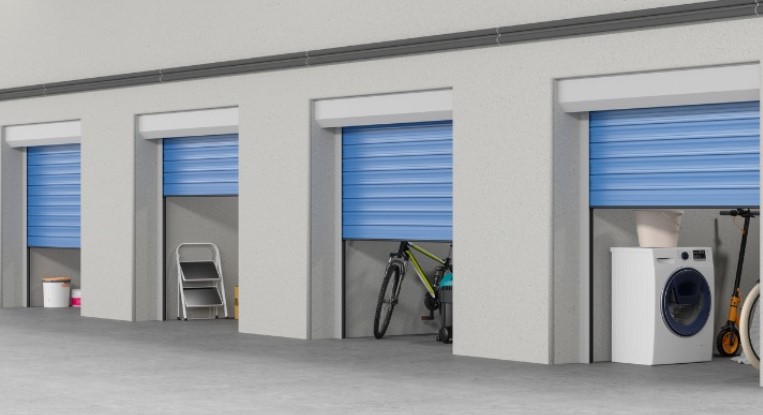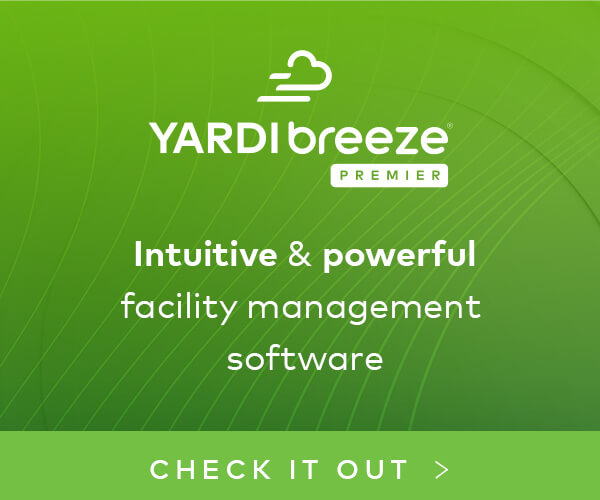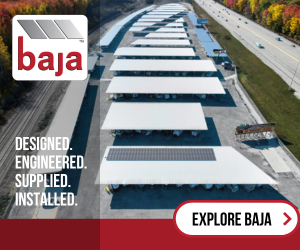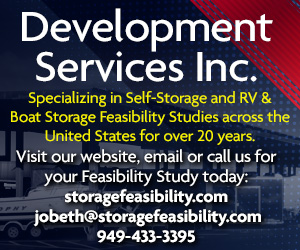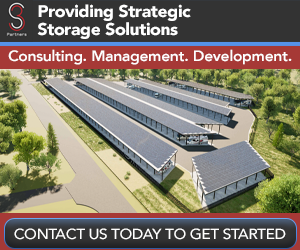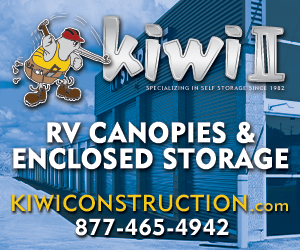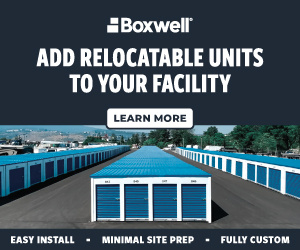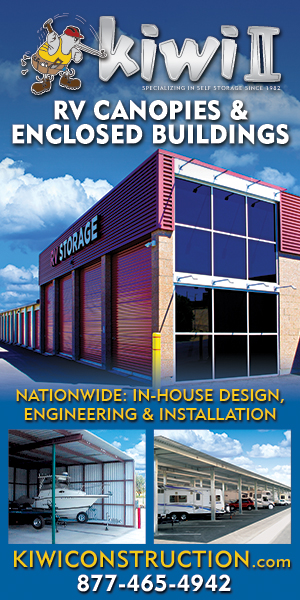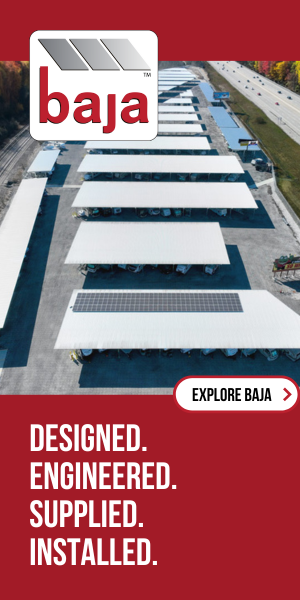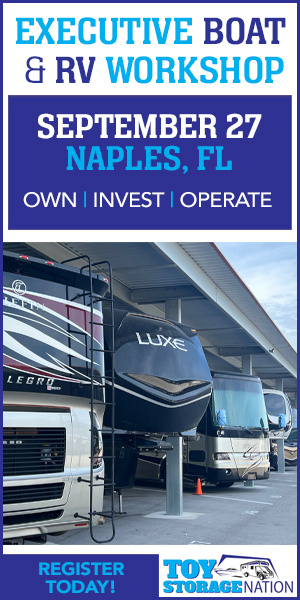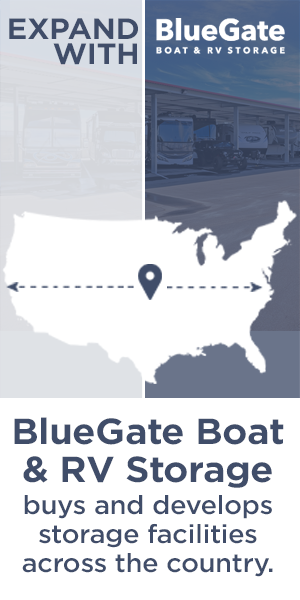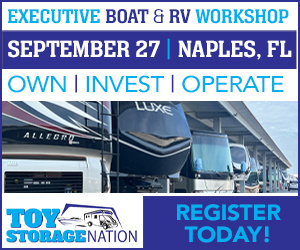Photo credit: Trachte Building Systems
By Ashley Kilroy
Real estate offers myriad investment choices, from single-family homes to data centers. The ideal asset for you depends on factors such as your investment size and strategy. Over the past several decades, investors have diversified their portfolios by capitalizing on emerging market opportunities like self-storage. In addition, vehicle storage has attracted the interest of many investors and developers, driving a spurt in the new emerging RV and boat storage industry.
Storage facilities serve as secure storage solutions for individuals and businesses, accommodating various products, materials and more. Given the high demand for spaces to store household belongings, business equipment and vehicles, storage facilities have become indispensable nationwide.
During the COVID-19 pandemic, throngs of people sought refuge in the great outdoors, the only place they could find sanctuary, away from crowds. They experienced great satisfaction, spending quality time with their families, away from the buzz of the news and a myriad of electronic distractions. Their love of adventures in the wild drove an upsurge in sales of RVs, camper trailers and other forms of rec vehicles, along with boats of all sizes.
While many are speculating on investing in this budding industry, a niche within the hugely successful self-storage sect, they often rely on the latter’s legacy, which has been building for the last several decades, as a compass for the future. This 101 in storage investing will likely set the scene for those interested in finding their new role in RV and boat storage.
Investing Basics
Self-storage investing means investing in storage units that individuals and businesses use to stow their spare belongings and assets. For example, a homeowner might need room for seasonal lawn equipment. For businesses, storage units can be used for surplus inventory instead of throwing it away. In either case, they’ll pay a storage facility a monthly fee to place their items in a secure unit. As an investor, you can own and operate a storage facility or purchase shares in a facility.
Self-storage is a solid investment for several reasons investors find attractive. First, the asset has high earning potential. Storage units cost less than residential real estate and other forms of commercial buildings, meaning more money in your pocket. For example, IBISWorld reported that the profit margin for storage units is 41%. In addition, storage revenue has increased by 2.1% over the past five years, making the industry worth over $29 billion.
Second, demand for self-storage continues to grow as baby boomers downsize and businesses shrink their workspaces.
The risk of investing in self-storage is low because of high profit margins and continuous demand. Customers need storage whether the economy is strong or a market downturn occurs. Therefore, the industry is a viable way to diversify your portfolio.
The Self-Storage Market
The specific type of storage unit you will promote depends on your client base. For example, if your ideal customers are sports enthusiasts, they may prefer padding, shelving and slat walls to store their equipment. On the other hand, a family moving across town might only need a bare unit to store their belongings temporarily. Therefore, understanding your target customers is vital in determining the type of units you purchase or build.
In addition, the lease contract terms are the backbone of the business, and you can adjust them monthly. This feature allows you to adjust prices from one month to another, unlike traditional real estate contracts, which do not apply to the self-storage market. As a result, you can change with the market and cater to your customers’ needs.
Fortunately, investors of all scopes and financial backgrounds can invest in storage units. For example, suppose you want to experiment with a modest investment in the self-storage industry. In that case, you can purchase shares in self-storage facilities. So, you can actively invest in self-storage (through ownership of a facility) or take the route of less commitment and risk through passive investment (shares in a company).
Types of Self-Storage Facilities
Self-storage facilities can be classified based on their purpose and capacity. Each type of facility has its advantages and disadvantages.
Climate-Controlled Storage
Certain items and materials are susceptible to damage from heat, cold or extreme humidity. For example, art, furniture and musical instruments benefit from climate control. To safeguard these items, climate-controlled storage units are available.
As a result, a regulated environment and security are top priorities when storing fragile possessions. Because climate-controlled storage units cater to various market needs, they are more expensive, and investors can charge higher prices for their specialized services.
Drive-Up & Outdoor Storage
Outdoor or drive-up storage is the most widespread type. It consists of rows of units resembling garages. By pulling up the door, the customer has complete access to their storage unit. These facilities are the most affordable option available.
One of the benefits of outdoor storage facilities is that they require minimal maintenance and employees. In addition, they are user-friendly, making them popular among individuals needing storage space. Lastly, these storage centers can bolster their security through cameras, electronic gates and security guards.
Mixed-Use Storage
The self-storage industry serves a diverse range of customers with varying needs. To meet these niche demands, many storage facilities combine different services, resulting in mixed-use storage facilities.
A significant advantage of mixed-use storage facilities is the ability to cater to various needs. For example, a self-storage facility strategically located in an urban setting can help nearby residents with extra belongings while serving local businesses. As a result, mixed-use storage facilities are flexible assets, offering solutions to a wide customer base.
Vehicle Storage
Self-storage facilities also help customers with vehicles such as cars, boats or RVs. Vehicle storage is an ideal solution for those seeking a sheltered, locked parking spot.
Vehicle storage often offers additional services, such as temperature-controlled units to ensure the preservation of classic cars. As a result, customers turn to these facilities annually to protect their vehicles, especially near high-demand spots such as airports and harbors.
How to Invest In Self-Storage
There are four primary ways you can get involved in a self-storage venture:
1. Purchase Shares in a Real Estate Investment Trust (REIT)
If you aren’t comfortable owning and operating an entire facility, you can invest in a real estate investment trust (REIT) instead. These companies spread investors’ money across various sectors and can have a particular focus. So, finding a REIT specializing in storage units can give you exposure to this profitable industry.
2. Invest in a Publicly Traded Storage Business
Similarly, you can buy shares in corporate storage companies on the stock market. If the company does well and the stock price increases, you can sell your shares for a profit.
3. Buy an Existing Facility
You can get more involved by purchasing a self-storage facility of your own. This option means running the business (or hiring workers to do so) and collecting monthly payments from your customers. As a result, you have higher earning potential than investing in a REIT.
4. Develop Your Own Facility
If there aren’t any facilities for sale near you, building one yourself is another option. Remember, you must purchase a suitable plot of land and manage the facility’s construction. While doing so takes additional time and money, it’s a way into owning a storage facility and enjoying the profits.
Is Storage Investing for You?
With all the preceding information in mind, you can decide how self-storage would fit into your portfolio. If you’re interested in real estate, self-storage is an excellent method because it is less expensive than typical commercial real estate. In addition, it requires less upkeep than residential buildings and can provide a steady cash flow every month.
Remember, a lump sum (usually tens or hundreds of thousands of dollars) is needed up front to invest in self-storage. You’ll purchase partial or full ownership of a facility or construct a facility from scratch. So, you must save up the required money or borrow it from a lender. Either way, these startup costs can be prohibitive to investors without the cash.
Lastly, you can take a less intense approach by investing in a REIT. If you like the self-storage business but don’t want to run a company, you can still enjoy the industry’s robust profit margin by putting money into shares in a self-storage business.
The Bottom Line
Investing in self-storage means purchasing a business or shares in a business that protects people’s possessions. Because this industry has a low overhead and charges monthly rent, investors can make substantial gains. To get a foothold in the business, you’ll need to select which type of storage you want to invest in, analyze your local market and find a need unmet by the competition. On the other hand, a self-storage REIT is a solid choice for those who prefer a less hands-on approach.
Tips for Investing in Storage Units
Self-storage units are excellent assets for a financial plan. However, it can be challenging to know how much cash to allocate toward it versus your other investments and priorities. Finding a financial advisor doesn’t have to be hard. SmartAsset’s free tool matches you with up to three vetted financial advisors who serve your area, and you can interview your advisor matches at no cost to decide which one is right for you. If you’re ready to find an advisor who can help you achieve your financial goals, get started now.
Ashley Kilroy is an experienced financial writer currently serving as an investment and insurance expert at SmartAsset. In addition to being a contributing writer at SmartAsset, she writes for solo entrepreneurs as well as for Fortune 500 companies. Ashley is a finance graduate of the University of Cincinnati. When she isn’t helping people understand their finances, you may find Ashley cage diving with great whites or on safari in South Africa.
Stake Your Claim in Toy Storage
Learn more about all aspects of developing and operating a successful RV and boat storage facility at the upcoming Toy Storage Nation Executive Workshop, June 16, at the foot of the Rocky Mountains in Denver/Boulder, Colo., where Mike Schwartz of RecNation RV & Boat Storage will lead a presentation on investing strategies for toy storage operators, and other industry experts will present on all angles of this thriving industry. Limited seats are available for this one-day accelerated, intensive workshop, led by the industry’s most seasoned professionals. REGISTER NOW










